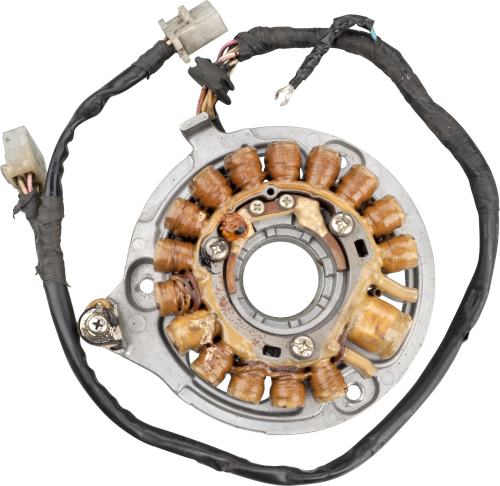Inspection of the SR500 ignition
The first thing to do is to check the individual components:
Wiring harness, kill switch, ignition lock, alternator, ignition plug, ignition coil, ignition cable. Often overlooked is the inspection of the kill switch. This sometimes generates a leakage current (permanent or short-term) and thus destroys the alternator. Checking is often not possible with a commercial multi-tester. Check the spark at the spark plug. Then disconnect the kill switch and check again. If the visually visible spark improves, your kill switch system is defective.
It is usually not necessary to check the C.D.I (ignition module). It is in the rarest cases the originator of ignition problems. In our experience, the most common defect is a faulty alternator in addition to old/broken spark plugs.
Why does this alternator - error occurs relatively frequently?
The coils in the alternator are very sensitive to leakage current, short circuit and lack of contact. The coil wire used must be very thin to achieve the required high ohm values in a small space. Therefore, the coils are very susceptible to overload. This is due to the design and can only be slightly improved by even the best repair.
Checking the ohm values:
Disconnect the alternator wiring harness six-way connector. Using an ohmeter, measure the wires indicated below against each other at the connector. Reference temperature is 20°C:
Ignition current coil (low speed): 329 Ohm (brown - black)
Ignition current coil (high speed): 334 ohms (red - black)
Ignition pulse coil (low speed): 87 ohms (white - green/black)
Ignition pulse coil (high speed): 16 ohms (white - red/black)
The most common source of failure is the 330 ohm coil. Values below 300 ohms indicate significant damage to the coil. Rewinding of the defective coil is then necessary. Depending on the condition of the engine (compression, oil consumption, carburetor setting, air filter, etc.), even a 330 ohm coil with 300-320 ohms can cause starting difficulties.
Often a thermal short circuit or ground fault occurs, i.e. the machine starts fine when cold, but there are starting problems when warm. If the machine cools down, it starts better again. The heating causes a short circuit to ground, often triggered by impurities (oil, moisture, etc.), which heat up, become thin and then penetrate the insulation layer of the alternator.
Caution - the SR alternator can be easily damaged or destroyed by improper handling, such as:.
Disconnecting the spark plug connector while the engine is running.
Kicking without a spark plug connected.
Too much spark advance/engine too hot. Check with strobe light (to be done after each assembly).
It is important to check the idle ignition setting:
SR500 1978 - 1983: slotted holes make adjustment of alternator possible (check with strobe lamp; F mark must align with housing mark at idle, from 1950 rpm the F mark must move away in the direction of early. This is the only relevant check. Checking the early adjustment up to 6000 rpm is not necessary for ignition adjustment.
SR500 1984-: no adjustment possible because there are no slotted holes.
The use of different alternator pole wheel combinations can lead to various malfunctions of the ignition system. There are three different types of SR-LiMa, recognizable by the position of the 330Ohm -coil (largest coil, conspicuous!).
10:00 (1978 - 1979)
01:00 (1980 - 1983)
06:00 (1984- [better 330 ohm coil] )
To the different alternators of course always different pole wheels were delivered.
There are three malfunctions with incorrect pairing of pole wheel and alternator:.
1. no ignition spark present.
2. no early adjustment; check at low speeds (from 1950 rpm); noticeable when driving in the city.
3. only 20° advance - almost not noticeable in normal driving; unfortunately, only one thing helps here - rev the engine up to 6000rpm and flash to see if 34° advance is achieved.
If you are not sure whether pole wheel/alternator are properly combined, you should definitely test it for the three errors described, otherwise the alternator will be overloaded in normal driving.
For the sake of completeness, you can also check the ignition coil. This is potted and therefore rarely a source of failure in the electrical system:
Primary coil (orange - ground bracket): 0.98 Ohm
Secondary coil (end of ignition cable - ground bracket): 12 kOhm (12000 Ohm)
The length of the ignition spark can also be measured, e.g. with an ignition spark distance tester. At 500 rpm (strong kick) the spark should bridge a distance of 6mm. Do not perform this check outside, but in the closed, windless garage.
 The store will not work correctly in the case when cookies are disabled.
The store will not work correctly in the case when cookies are disabled. Der Shop wird nicht korrekt funktionieren, wenn Cookies deaktiviert sind.
Der Shop wird nicht korrekt funktionieren, wenn Cookies deaktiviert sind. La boutique ne fonctionnera pas correctement si les cookies sont désactivés.
La boutique ne fonctionnera pas correctement si les cookies sont désactivés.